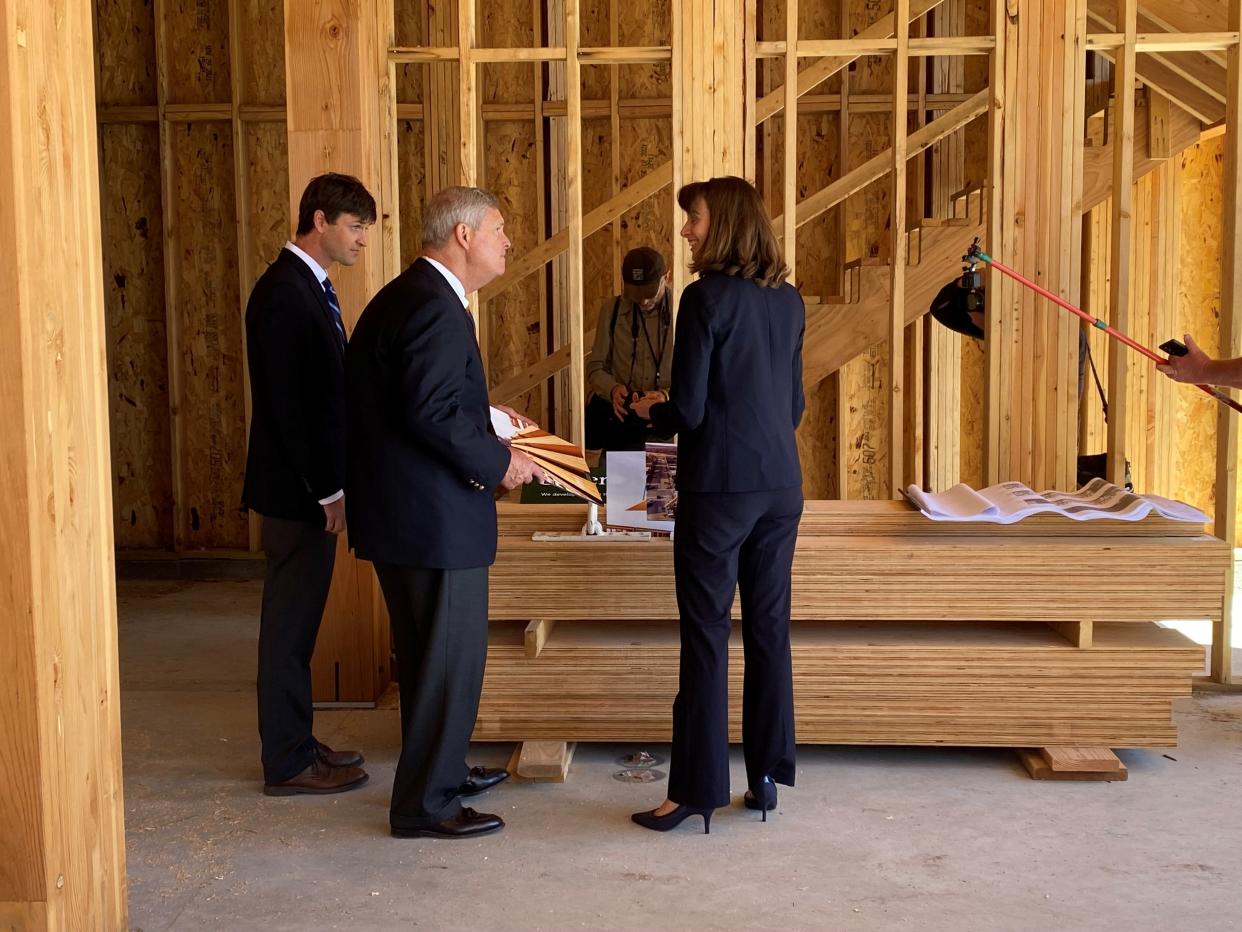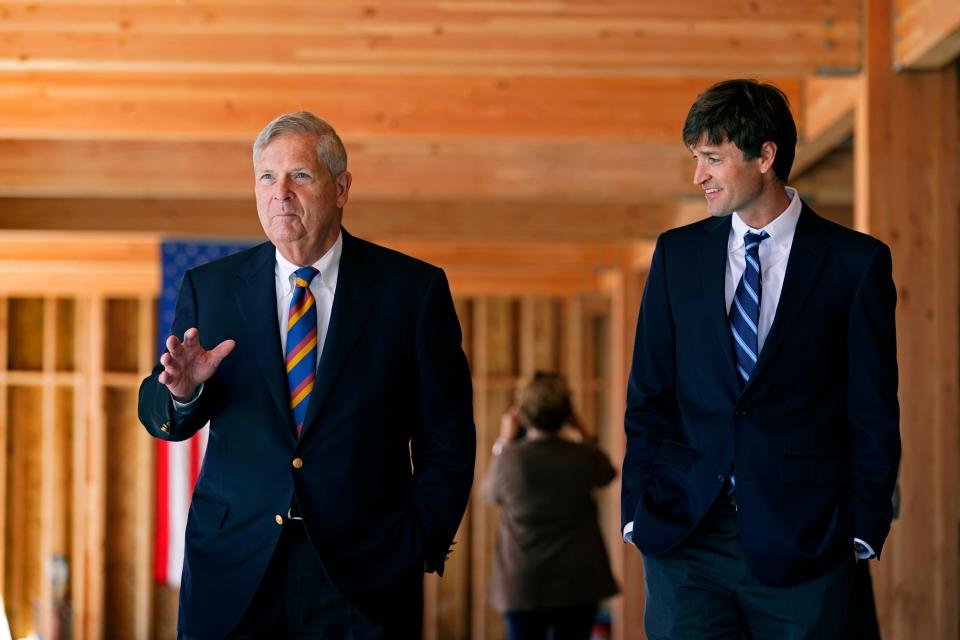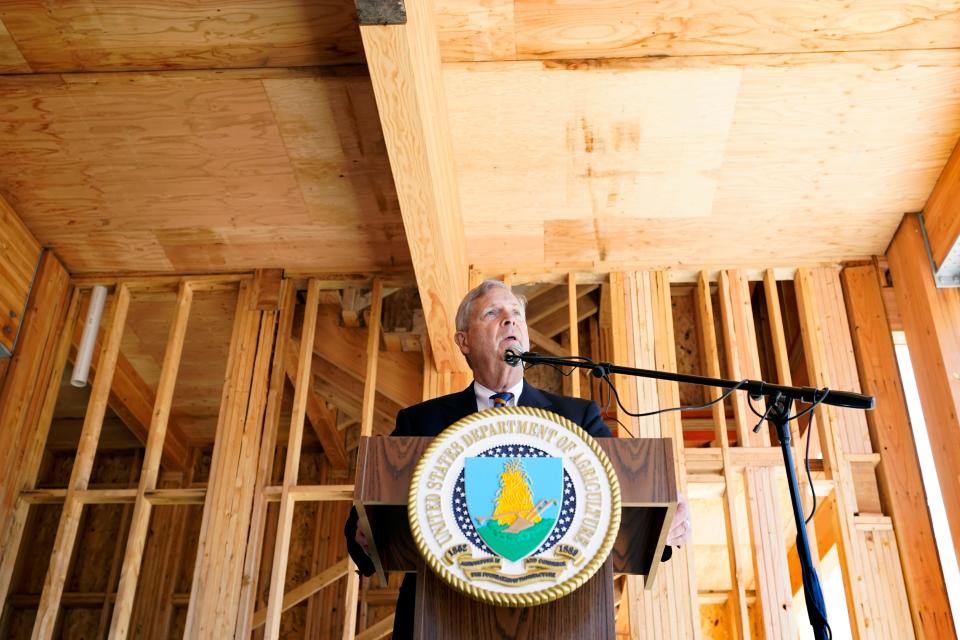In Iowa, Ag Secretary Tom Vilsack unveils grants to turn problem forests into eco-friendly buildings

- Oops!Something went wrong.Please try again later.
Overgrown forests full of small-diameter trees help fuel the growing problem of wildfires.
At the same time, a rarely used building product called mass timber can make use of just that sort of wood.
Seeking to bring together the problem and a potential solution, U.S. Agriculture Secretary Tom Vilsack visited the site of a West Des Moines mass timber construction project Friday to announce the allocation of more than $32 million to fund the U.S. Department of Agriculture's wood innovations and community wood grant programs.
The former Iowa governor said the money will be awarded to projects that help clear the problematic forest land by making use of the small-diameter trees.
The Junction Development Catalyst project site, a mixed-use building under construction at 304 Fifth St. in the Valley Junction business district, is just the second in Iowa to use mass timber, a sustainable product made by pressing together smaller planks of wood into larger pieces, similar to wood beams found in some historic structures. It's the first in the state to use the product for affordable housing, with 11 units for rent to tenants earning 80% of the area median income.
The building also will have ground-floor retail and restaurant space. Two commercial offices will be available on the second and third floors. Des Moines-based Cutler Development received $250,000 from last year's round of wood innovation grants for the West Des Moines project.
Mass timber project planned for Ingersoll gas station site

This year's grants will fund 99 projects in 30 states, including another $250,000 to Cutler Development and nonprofit organization Anawim Housing for a mixed-use mass timber building planned at the site of the Star gas station, 2701 Ingersoll Ave., Des Moines.
Plans for that project are in the preliminary stages, said Scott Cutler, who owns Cutler Development with his wife, Molly.
Des Moines' first mass timber building is an East Village landmark: 111 E. Grand Ave., the block-long, four-story structure that is home to several offices and restaurants Clyde's Fine Diner and Franka Pizzeria. Completed in 2019, it has the contemporary style of many of its brick-and-mortar neighbors. But a close look reveals the different nature of its construction, with wooden pillars, beams and planking.
Likewise, Junction Development Catalyst will have exposed mass timber beams to show off the beauty of the product.
More: East Village Spa announces move to nearby location for added space, parking
"When you look around, you see mass timber columns, beams and decking. Mass timber, in addition to offering the unique and warm aesthetic we see here today, is sustainable, and renewable and sequesters environmental carbon," Cutler said. "While it has many clear benefits, mass timber construction is still somewhat new to the market, but this is changing. And hopefully soon, mass timber construction will be commonplace."
The wood innovations and community wood grant programs are being funded in part with $12 million from the federal infrastructure package, signed into law by President Joe Biden last year.
The pluses: Beauty, environmental benefit, energy savings
The bill also includes money to clear diseased and burnt small-diameter trees from 20 million acres owned by the U.S. Forest Service and 30 million acres of private land to "reduce the hazard of these enormous forest fires that threaten life and property," Vilsack said. An additional 1.2 billion trees will be planted as part of the infrastructure bill.
That harvested wood will be used to create products like mass timber for sustainable, environmentally friendly development across the country, which is where the grant programs come into play. Vilsack estimates there are 17,000 buildings built each year that could use mass timber, but only 40 to 50 do.
"It doesn't work unless there is an incentive to make it work. When you bring something new into the marketplace, it's hard because you're competing against existing construction activities and existing thought processes in architecture and design," he said. " ... We created and resourced (the grant programs) with the idea that we would invest in projects like this one, to encourage these projects to be built and developed so that people could see the beauty and the environmental benefit, the energy savings benefit that's associated with this type of construction."

Cutler said the cost to develop a mass timber building is slightly more than using steel, concrete and lumber. But he attributes that to it being a newer construction method and said he hopes costs will go down as more architects, engineers, contractors and developers embrace the material.
The real cost savings, Vilsack said, is the energy efficiency mass timber buildings provide. Wood's superior insulating properties have long been recognized. Plus, as trees grow, they sequester carbon in their wood. That could have a net benefit in the fight against climate change, avoiding the fossil fuel emissions that come with manufacturing traditional building materials, Vilsack said.
More: See 6 big ideas for downtown Des Moines, from a connected greenway to public art in skywalk
There's also a cost benefit when it comes to preventing wildfires: It costs $1,500 per acre to clear a forest of hazards, but $50,000 an acre to fight a fire, Vilsack said.
Kim Norvell covers growth and development for the Register. Reach her at knorvell@dmreg.com or 515-284-8259. Follow her on Twitter @KimNorvellDMR.
This article originally appeared on Des Moines Register: Tom Vilsack unveils USDA funds for eco-friendly mass timber buildings

